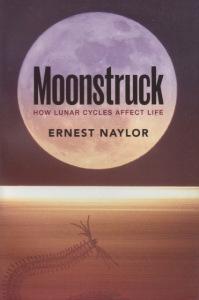 Scientists, often with their base matrix bound up with the local religion, are frequently interested in myth. And sometimes religion too.This is no surprise.Many of us go into religious studies because of its influence on our lives and scientists, who measure and analyze material realities, must be curious when their results challenge some religious or mythic assumptions.So it is that Ernest Naylor addresses mythic beliefs about the moon’s influence on animals and what scientific findings on the same show.Although this book wasn’t exactly what I thought it would be, Moonstruck: How Lunar Cycles Affect Life does address the subtitle assertion quite directly.Naylor, a marine zoologist, knows about tides—caused by the moon—and their effects on marine organisms.That connection is the main focus of the book, with occasional forays onto dry land.
Scientists, often with their base matrix bound up with the local religion, are frequently interested in myth. And sometimes religion too.This is no surprise.Many of us go into religious studies because of its influence on our lives and scientists, who measure and analyze material realities, must be curious when their results challenge some religious or mythic assumptions.So it is that Ernest Naylor addresses mythic beliefs about the moon’s influence on animals and what scientific findings on the same show.Although this book wasn’t exactly what I thought it would be, Moonstruck: How Lunar Cycles Affect Life does address the subtitle assertion quite directly.Naylor, a marine zoologist, knows about tides—caused by the moon—and their effects on marine organisms.That connection is the main focus of the book, with occasional forays onto dry land.
What caught my attention right away was that when discussing myth and religious ideas, Naylor describes two stories as biblical: the woodcutter banished for gathering on the Sabbath and Judas’ banishment.Both of these, he seems to believe, have the Bible banishing the criminals to the moon.That was news to me.There may well be folklore with such associations, but a simple opening of the covers of the Good Book would dispel this particular “myth.”Neither the sabbath wood-gatherer nor Judas were banished to the moon after their deaths.The former presumably went to Sheol and the latter presumably to Hell.For me this illustrates yet again how many ideas professional people outside the guild suppose to be “biblical.”The Bible says very little about the moon.One New Testament demoniac is described as “moonstruck,” but beyond that the occasional references are mainly just to the moon qua moon.
The Bible’s a big book.Everyone in western society knows it’s an important book but few read it.Even fewer deeply engage with it to understand its original context and message.We hear stuff and we’re told it’s in there, and we believe it.I first noticed this in high school.Classmates would tell me “the Bible says…” (you can fill in the blank with just about anything, this isn’t a quiz).Almost always they were wrong.By that point I’d read the Good Book many times cover-to-cover.I owned concordances and knew when foreign matter was introduced.The thing about the Bible is that it’s fairly simple to look it up.Moonstruck focuses on marine animals and tells interesting connections to the moon.It has a chapter on humans and the moon, finding little direct biological influence.It’s an informative book, just don’t use it to verify what’s in the Bible.
